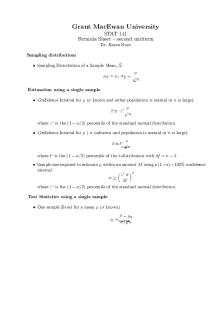Greggs Questions - Lecture notes 2 PDF

| Title | Greggs Questions - Lecture notes 2 |
|---|---|
| Author | Anonymous User |
| Course | Industrial Economics |
| Institution | University of Nottingham |
| Pages | 2 |
| File Size | 39.2 KB |
| File Type | |
| Total Downloads | 20 |
| Total Views | 128 |
Summary
greggs analystist...
Description
20 Questions on Greggs plc.
1.
Describe the main business activities of Greggs. What is Greggs’ vision, and how will they achieve it? (Hint – what are the 4 key pillars of Greggs’ strategy) 2. Briefly outline the progress made in 2019 towards implementation of its strategy. 3. What is the outlook for 2020? 4. What are the eight key financial performance indicators used by Greggs directors to “monitor the performance of the group” against its strategy? 5. Was 2019 ‘a good year' for Greggs? (Justify your opinion) 6. What are the main exceptional items reported in Greggs financial statements? (Consolidated income statement, p. 94, and note 4, Exceptional items, p. 111). 7. What is meant by “Profit before tax (PBT)” and “PBT margin”? Explain why “the underlying measure excludes any exceptional items arising in the year” (p. 24). 8. Looking at the balance sheet (p. 95), how important are property, plant and equipment (PP&E) as a proportion of group assets? What are the three key categories of PP&E and how are they depreciated? (Significant accounting policies (h), p. 104). 9. What is the nature of intangible assets and their carrying value? (Balance sheet - p. 95 and note 10 – p. 116). How are intangible assets disclosed in the accounts? (See: Significant accounting policies (f), p. 103). 10. The 2019 “Profit for the financial year attributable to equity holders of the Parent” was £87 million (Consolidated income statement, p. 94). However, the “Total equity attributable to equity holders of the Parent” reported in the year-end Balance sheet (p. 95) only increased by £18 million. Why? (Hint – review Statement of changes in equity, p. 96). 11. “It is the responsibility of the Auditors to prepare financial statements that give a true and fair view of the group’s financial affairs”. Is this statement true? (Provide evidence from the Annual Report to support your answer.) 12. Who are the Auditors? What were they paid for the audit of these accounts? What were they paid for other services? (Note 3, p. 110). 13. What time period do the financial statements cover? On what date were the accounts approved by the Board of Directors? What is the date of the Auditor’s report? What key significance do these dates have to disclosures in the accounts? 14. What are the four columns in the Balance Sheet (or Statement of Financial Position)? Which two columns on the Balance Sheet are
Greggs Plc shareholders most likely to be interested in when conducting financial analysis. 15. Describe how the accruals (matching) concept is applied in financial statements and present evidence of this concept’s application in Greggs’ accounts. 16. What was the expenditure on new, tangible non-current assets during the year? What was the depreciation charge in relation to non-current assets for the year? 17. What are current assets? What are the main categories of current assets represented by the £142.3 million in Greggs’ balance sheet? 18. What are current liabilities? What are the main categories of current liabilities represented by the £208.7 million in Greggs’ balance sheet? 19. What is Greggs’ interest-bearing debt (borrowings) as at 31 December 2019? Explain what might be considered significant or unusual about your answer to this question 20. What is Greggs’ earnings per share (EPS) for 2019? By how much did it grow compared to 2018? Why is EPS shown on the face of the consolidated income statement (p. 80)? What is “Diluted EPS”....
Similar Free PDFs

Lecture notes, lecture 2
- 3 Pages

2 - Lecture notes 2
- 5 Pages

Lecture notes, lecture Chapter 2
- 11 Pages

Lecture notes, lecture formula 2
- 1 Pages

FRA1021 notes 2 questions
- 8 Pages

Jeopardy Questions - Lecture notes 4
- 10 Pages

2 Biodiversity - Lecture notes 2
- 33 Pages

Chapter 2 - Lecture notes 2
- 30 Pages
Popular Institutions
- Tinajero National High School - Annex
- Politeknik Caltex Riau
- Yokohama City University
- SGT University
- University of Al-Qadisiyah
- Divine Word College of Vigan
- Techniek College Rotterdam
- Universidade de Santiago
- Universiti Teknologi MARA Cawangan Johor Kampus Pasir Gudang
- Poltekkes Kemenkes Yogyakarta
- Baguio City National High School
- Colegio san marcos
- preparatoria uno
- Centro de Bachillerato Tecnológico Industrial y de Servicios No. 107
- Dalian Maritime University
- Quang Trung Secondary School
- Colegio Tecnológico en Informática
- Corporación Regional de Educación Superior
- Grupo CEDVA
- Dar Al Uloom University
- Centro de Estudios Preuniversitarios de la Universidad Nacional de Ingeniería
- 上智大学
- Aakash International School, Nuna Majara
- San Felipe Neri Catholic School
- Kang Chiao International School - New Taipei City
- Misamis Occidental National High School
- Institución Educativa Escuela Normal Juan Ladrilleros
- Kolehiyo ng Pantukan
- Batanes State College
- Instituto Continental
- Sekolah Menengah Kejuruan Kesehatan Kaltara (Tarakan)
- Colegio de La Inmaculada Concepcion - Cebu







